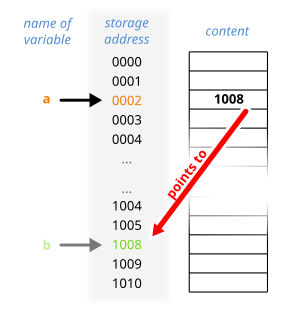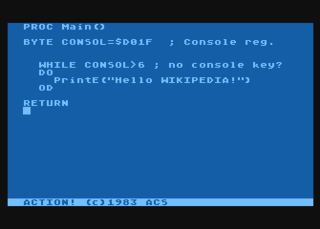Related Research Articles

C is a general-purpose, procedural computer programming language supporting structured programming, lexical variable scope, and recursion, with a static type system. By design, C provides constructs that map efficiently to typical machine instructions. It has found lasting use in applications previously coded in assembly language. Such applications include operating systems and various application software for computer architectures that range from supercomputers to PLCs and embedded systems.
In computer science, an integer is a datum of integral data type, a data type that represents some range of mathematical integers. Integral data types may be of different sizes and may or may not be allowed to contain negative values. Integers are commonly represented in a computer as a group of binary digits (bits). The size of the grouping varies so the set of integer sizes available varies between different types of computers. Computer hardware nearly always provides a way to represent a processor register or memory address as an integer.
OCaml is a general-purpose, multi-paradigm programming language which extends the Caml dialect of ML with object-oriented features. OCaml was created in 1996 by Xavier Leroy, Jérôme Vouillon, Damien Doligez, Didier Rémy, Ascánder Suárez, and others.

PIC is a family of microcontrollers made by Microchip Technology, derived from the PIC1650 originally developed by General Instrument's Microelectronics Division. The name PIC initially referred to Peripheral Interface Controller, and is currently expanded as Programmable Intelligent Computer. The first parts of the family were available in 1976; by 2013 the company had shipped more than twelve billion individual parts, used in a wide variety of embedded systems.
In computer programming, a parameter or a formal argument is a special kind of variable used in a subroutine to refer to one of the pieces of data provided as input to the subroutine. These pieces of data are the values of the arguments with which the subroutine is going to be called/invoked. An ordered list of parameters is usually included in the definition of a subroutine, so that, each time the subroutine is called, its arguments for that call are evaluated, and the resulting values can be assigned to the corresponding parameters.

The syntax of the C programming language is the set of rules governing writing of software in the C language. It is designed to allow for programs that are extremely terse, have a close relationship with the resulting object code, and yet provide relatively high-level data abstraction. C was the first widely successful high-level language for portable operating-system development.

In computer science, a pointer is an object in many programming languages that stores a memory address. This can be that of another value located in computer memory, or in some cases, that of memory-mapped computer hardware. A pointer references a location in memory, and obtaining the value stored at that location is known as dereferencing the pointer. As an analogy, a page number in a book's index could be considered a pointer to the corresponding page; dereferencing such a pointer would be done by flipping to the page with the given page number and reading the text found on that page. The actual format and content of a pointer variable is dependent on the underlying computer architecture.
In computer programming, undefined behavior (UB) is the result of executing a program whose behavior is prescribed to be unpredictable, in the language specification to which the computer code adheres. This is different from unspecified behavior, for which the language specification does not prescribe a result, and implementation-defined behavior that defers to the documentation of another component of the platform.
In computer programming, particularly in the C, C++, C#, and Java programming languages, the volatile keyword indicates that a value may change between different accesses, even if it does not appear to be modified. This keyword prevents an optimizing compiler from optimizing away subsequent reads or writes and thus incorrectly reusing a stale value or omitting writes. Volatile values primarily arise in hardware access, where reading from or writing to memory is used to communicate with peripheral devices, and in threading, where a different thread may have modified a value.

Action! is a procedural programming language and integrated development environment written by Clinton Parker for the Atari 8-bit family. The language, which is similar to ALGOL, compiled to high-performance code for the MOS Technologies 6502 of the Atari computers. Action! was distributed on ROM cartridge by Optimized Systems Software starting in 1983. It was one of the company's first bank-switched "Super Cartridges", with a total of 16 kB of code.
In the C, C++, D, JavaScript and Julia programming languages, const is a type qualifier: a keyword applied to a data type that indicates that the data is read only. While this can be used to declare constants, const in the C family of languages differs from similar constructs in other languages in being part of the type, and thus has complicated behavior when combined with pointers, references, composite data types, and type-checking.
Thread-local storage (TLS) is a computer programming method that uses static or global memory local to a thread.
A class in C++ is a user-defined type or data structure declared with keyword class that has data and functions as its members whose access is governed by the three access specifiers private, protected or public. By default access to members of a C++ class is private. The private members are not accessible outside the class; they can be accessed only through methods of the class. The public members form an interface to the class and are accessible outside the class.
In computer science, type punning is a common term for any programming technique that subverts or circumvents the type system of a programming language in order to achieve an effect that would be difficult or impossible to achieve within the bounds of the formal language.
OptimJ is an extension for Java with language support for writing optimization models and abstractions for bulk data processing. The extensions and the proprietary product implementing the extensions were developed by Ateji which went out of business in September 2011. OptimJ aims at providing a clear and concise algebraic notation for optimization modeling, removing compatibility barriers between optimization modeling and application programming tools, and bringing software engineering techniques such as object-orientation and modern IDE support to optimization experts.
Charm is a computer programming language devised in the early 1990s with similarities to the RTL/2, Pascal and C languages in addition to containing some unique features of its own. The Charm language is defined by a context-free grammar amenable to being processed by recursive descent parser as described in seminal books on compiler design.
The computer programming languages C and Pascal have similar times of origin, influences, and purposes. Both were used to design their own compilers early in their lifetimes.
In computer programming, a subroutine is a sequence of program instructions that performs a specific task, packaged as a unit. This unit can then be used in programs wherever that particular task should be performed.
In the C, C++, and D programming languages, a type qualifier is a keyword that is applied to a type, resulting in a qualified type. For example, const int is a qualified type representing a constant integer, while int is the corresponding unqualified type, simply an integer. In D these are known as type constructors, by analogy with constructors in object-oriented programming.

Nim is an imperative, general-purpose, multi-paradigm, statically typed, and expressive, systems compiled programming language, designed and developed by a team around Andreas Rumpf. Nim is designed to be "efficient, expressive, and elegant", supporting metaprogramming, functional, message passing, procedural, and object-oriented programming styles by providing several features such as compile time code generation, algebraic data types, a foreign function interface (FFI) with C, C++, Objective-C, and JavaScript, and supporting compiling to those same languages.
References
- ↑ "INTERNATIONAL STANDARD ISO/IEC 9899:TC2" (PDF).
- ↑ "MPLAB® XC32 C/C++ Compiler User's Guide" (PDF). p. 170.